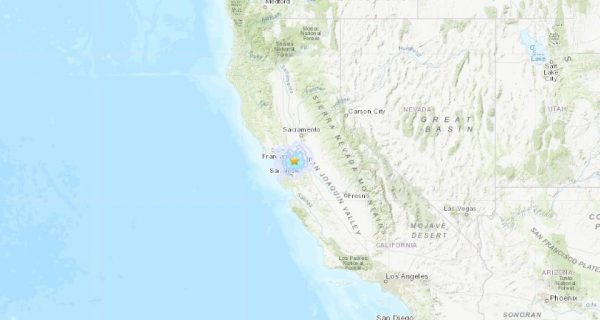An earthquake with a preliminary 4.3 magnitude has rattled parts of the San Francisco Bay Area. There are no immediate reports of damage.
The quake struck Tuesday afternoon 9 miles south of Brentwood, California.
People took to social media to say they felt a sharp jolt in the area east of San Francisco.
The tremor was centered about 7.7 miles east of Blackhawk and 8.2 miles north of Livermore, according to the U.S. Geological Survey (USGS), which said it occurred around 1:11 p.m.
NBC Bay Area reported that a number of residents in the East Bay, which includes cities such as Berkeley and Oakland, and the South Bay, which includes San Jose and Sunnyvale, felt the earthquake.

“Mother Nature just reminded us why we need to be prepared for an #earthquake and be able to sustain ourselves and communities,” the Alameda County Sheriff’s Office tweeted.
Mother Nature just reminded us why we need to be prepared for an #earthquake and be able to sustain ourselves and communities. Sign up for https://t.co/shd6ZnNxUy and get started.
— Alameda County Sheriff (@ACSOSheriffs) July 16, 2019
A 3.5 magnitude earthquake hit the same area about 13 minutes later, the USGS said. A day before, a 3.3 magnitude earthquake hit the South Bay, the NBC affiliate noted.
On social media, people reported feeling the tremor.
* earthquake in the Bay Area*
Me: pic.twitter.com/mo3d1gw0v6
— Jordan???? (@jord_n_) July 16, 2019
oakland y’all felt the earthquake earlier?
— ???????? (@missallyjai) July 16, 2019
Another Earthquake in CA and this time it was onlyb30 miles away! ???????? I’m freaking out.
— Samantha Manning (@smanning48464) July 16, 2019
apparently an earthquake was felt in 209 ????mother nature chilllll
— Mike???? (@MikeManythong) July 16, 2019
The 4.3 magnitude quake comes less than two weeks after a pair of powerful earthquakes rocked a remote desert area in Southern California, damaging homes, buckling roads and rupturing gas lines.
Simulation Reveals What a 7.0 Earthquake Would Look Like in San Francisco Bay
California’s Hayward fault line is long overdue for a significant earthquake, according to experts. Accordingly, the US Geological Survey ran a simulation on the Hayward fault to help predict the consequences of a magnitude 7 earthquake on the Bay Area.
As the southwestern side of California slides up and northwestward towards Alaska compared to its northeastern half earthquakes will occur mostly along the San Andreas, the San Jacinto and Hayward Faults, and also in the Mojave Desert.
Ridgecrest, California, was once known as the earthquake capital of the world. The 7.1 magnitude earthquake in the Mojave Desert that shook the town on July 5 caused relatively minor damage. Direction matters and most of the force spread away from inhabited areas, and Ridgecrest received a glancing blow. Even so, there was significant damage to homes, businesses, and roads.

Ole Kaven, is a research geophysicist in Menlo Park that specializes in the area. He said the aftershocks appear to be dying down, adding that the area has so far shown no sign of another approaching quake.
“It’s the Airport Lake Fault Zone. It has seen seismicity in the past, but this is certainly the largest earthquake on that particular fault,” said Kaven. “The Navy base that’s in the area just to the north and where most of the seismic activity is taking place has also sustained some damage. We have not received any reports of serious injuries or fatalities.”
Earthquake activity can be seen online in real-time on the USGS website. Red dots represent the last hour where an earthquake occurred, orange ones represent the previous 24 hours, and the yellow ones represent about seven days. The larger the dot or circle, the greater the intensity.

According to Kaven, these quakes are of similar intensity to what they expect in the Bay Area. Earthquakes on the Hayward, Calaveras, and San Andreas Faults would cause the most damage since they are close to urban areas. He pointed out that the Hayward Fault line runs a higher risk of experiencing a magnitude of 7 or higher earthquake.
Knowing how to respond when disaster hits decrease the risk of injury. Aside from the standard drop, cover, and hold, Kaven also recommends additional safety measures.
“Preparation for such an event, make sure you have an emergency kit at home, make sure you know where you can shut off the main gas valve. Gas lines can often rupture in the event of this type of shaking and can cause fires. Which did happen in the Ridgecrest area,” said Kaven.
Locals are urged to take precautions and educate themselves on what to do if disaster hits. They are also instructed to report the quake – this helps first responders to act more quickly in an emergency.
That fault line hasn’t had a significant earthquake in over 150 years, and experts say it’s long overdue.
NTD reporter Ilene Eng, Epoch Times Jack Phillips and The Associated Press contributed to this report


